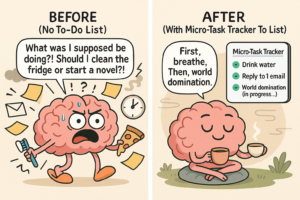Picture this: you’re sitting at your desk, trying to focus on a single task, but your mind feels like a browser with 87 tabs open. There’s the email you need to send, the grocery list you keep forgetting, the project deadline looming, and that nagging thought about calling your friend back. Oh, and did you pay that bill? Each tab is vying for your attention, and somehow, none of them are related to the task you’re actually trying to complete. Sound familiar?
Why Your Brain Isn’t Built to Hold Everything
 To understand why writing down your goals is so powerful, we need to take a quick look at how your brain operates. Your brain is a magnificent machine, capable of incredible feats of creativity, problem-solving, and adaptation. But it has its limits. Contrary to what many of us assume, it’s not designed to be a storage unit. It’s a processor, not a filing cabinet.
To understand why writing down your goals is so powerful, we need to take a quick look at how your brain operates. Your brain is a magnificent machine, capable of incredible feats of creativity, problem-solving, and adaptation. But it has its limits. Contrary to what many of us assume, it’s not designed to be a storage unit. It’s a processor, not a filing cabinet.Think of your brain as a high-performance computer with limited RAM. When you try to keep all your goals, tasks, reminders, and future plans in your head, it’s like running dozens of programs at once. The system slows down, glitches, and sometimes crashes. You might forget an important deadline, feel overwhelmed by vague anxieties, or struggle to focus on the present moment. This mental overload isn’t a sign of failure—it’s a sign that you’re asking your brain to do something it wasn’t built for.
Psychologists have a name for this phenomenon: the Zeigarnik Effect. Discovered by Russian psychologist Bluma Zeigarnik in the 1920s, this effect describes how your brain tends to hold onto unfinished tasks, looping them in your mind until they’re resolved. Ever wonder why you can’t stop thinking about that email you haven’t sent or the project you haven’t started? That’s the Zeigarnik Effect at work. These incomplete tasks create mental clutter, sapping your cognitive resources and making it harder to focus, relax, or even sleep.
 Now, imagine trying to stuff your entire wardrobe into a single drawer. Socks, shirts, and sweaters are crammed together, and every time you need something, you have to dig through the mess. Something’s bound to get wrinkled, lost, or forgotten. That’s exactly what happens when you rely on your brain to store all your goals and tasks. Writing down your goals is like organizing that drawer—suddenly, everything has a place, and you can find what you need when you need it.
Now, imagine trying to stuff your entire wardrobe into a single drawer. Socks, shirts, and sweaters are crammed together, and every time you need something, you have to dig through the mess. Something’s bound to get wrinkled, lost, or forgotten. That’s exactly what happens when you rely on your brain to store all your goals and tasks. Writing down your goals is like organizing that drawer—suddenly, everything has a place, and you can find what you need when you need it.The Mental Detox You Didn’t Know You Needed
So, what happens when you externalize your goals by writing them down? Whether you use a notebook, a whiteboard, a task tracker app, or even a sticky note, the act of putting your thoughts on paper (or a screen) is like hitting the reset button on your brain. It’s a mental detox that clears out the clutter and creates space for what really matters.
Here are some of the benefits you’ll notice when you make writing down your goals a habit:
-
Better Focus on What Matters Now
When your brain isn’t frantically trying to remember everything, it can zero in on the task at hand. Instead of juggling 87 mental tabs, you can close the irrelevant ones and focus on the one that’s open. This laser-like focus is essential for getting things done, whether you’re tackling a work project, cooking dinner, or simply enjoying a moment of peace.
-
Improved Creativity
A cluttered mind is a creativity killer. When your brain is preoccupied with remembering tasks, it has little room for brainstorming, problem-solving, or dreaming big. By offloading your goals onto paper, you free up cognitive bandwidth for creative thinking. Ever notice how your best ideas come when you’re relaxed, like in the shower or on a walk? Writing down your goals creates that same sense of mental spaciousness, even in the midst of a busy day.
-
Deeper Relaxation, Especially at Night
If you’ve ever lain awake at night, your mind racing with thoughts of what you need to do tomorrow, you know how exhausting mental clutter can be. Writing down your goals before bed—whether it’s a to-do list for the next day or a brain dump of everything on your mind—signals to your brain that it’s safe to let go. This practice, often called a “brain dump,” can be a game-changer for improving sleep quality and reducing anxiety.
-
Greater Motivation Through Visible Progress
There’s something deeply satisfying about crossing a task off your list. When you write down your goals, you create a tangible record of what you’re working toward. Each checkmark or completed task becomes a small win, boosting your motivation and reinforcing your sense of accomplishment. Over time, these small wins add up, helping you build momentum toward bigger goals.
In essence, writing down your goals is like cleaning out that messy drawer. You don’t just find what you were looking for—you feel lighter, more organized, and ready to take on the day.
The Science Behind Why Writing Works
 Let’s dive a bit deeper into why this simple act is so effective. Writing down your goals doesn’t just feel good—it’s backed by science. Here’s how it works:
Let’s dive a bit deeper into why this simple act is so effective. Writing down your goals doesn’t just feel good—it’s backed by science. Here’s how it works:1. Clarifies Your Priorities
Your mind is a whirlwind of thoughts, and it’s easy to feel like everything is equally important. But when you sit down to write out your goals, you’re forced to make choices. What are the top three things you need to accomplish today? What can wait until next week? This process of prioritization helps you cut through the noise and focus on what truly matters.
In a 2018 study published in the Journal of Applied Psychology, researchers found that individuals who wrote down their goals were significantly more likely to achieve them than those who kept their goals in their heads. The act of writing creates a mental commitment, making your goals feel more concrete and actionable.
2. Creates Structure and Flow
A goal written down becomes a task. A task becomes a series of steps. And steps? They get done. Writing transforms vague intentions (“I should get in shape”) into specific, actionable plans (“Go for a 20-minute walk after work”). This structure provides a roadmap for your day, week, or even year, turning overwhelming ambitions into manageable chunks.
The concept of “flow,” introduced by psychologist Mihaly Csikszentmihalyi, describes a state of deep focus and immersion in a task. When your goals are clearly defined and organized, you’re more likely to enter this flow state, where time seems to disappear, and productivity soars.
3. Stops Overthinking and Reduces Cognitive Load
Your brain has a finite amount of mental energy. When it’s bogged down by the effort of remembering tasks, it has less energy for decision-making, problem-solving, and creativity. This is known as cognitive load, and it’s a major contributor to stress and burnout.
By externalizing your goals, you reduce cognitive load, freeing your brain to focus on higher-order thinking. A 2011 study in the Journal of Personality and Social Psychology found that writing down tasks and plans significantly reduced intrusive thoughts and improved mental clarity. In other words, when you trust your system—whether it’s a notebook or an app—you don’t have to keep everything in your head.
4. Encodes Information in Your Memory
Writing engages multiple parts of your brain, including those responsible for motor skills, visual processing, and memory. This multi-sensory experience helps “encode” your goals more deeply into your memory, making them easier to recall and act on. A 2008 study from the Journal of Cognitive Neuroscience showed that handwritten notes, in particular, enhance memory retention compared to typing or mental note-taking.
How to Make Writing Down Goals a Habit
 Convinced that writing down your goals is worth a try? Great! The key to reaping the benefits is consistency. Here’s how to turn this practice into a habit that sticks:
Convinced that writing down your goals is worth a try? Great! The key to reaping the benefits is consistency. Here’s how to turn this practice into a habit that sticks:Step 1: Start Small
You don’t need to overhaul your entire life to see results. Begin with a simple challenge: spend 5 minutes each morning or evening writing down your top three goals for the day or week. These could be work-related (“Finish the client presentation”), personal (“Drink 8 glasses of water”), or even emotional (“Call Mom to check in”).
The key is to keep it manageable. Three goals are enough to focus your attention without overwhelming you. As you get comfortable, you can expand to weekly or monthly goals.
Step 2: Choose Your Medium
There’s no one-size-fits-all tool for writing down goals. Experiment to find what works for you:
-
Pen and Paper: A notebook or planner is tactile, distraction-free, and great for those who love the physical act of writing.
-
Digital Apps: Tools like Todoist, Notion, or Google Keep are perfect for tech-savvy users who want to sync their goals across devices.
-
Whiteboard or Sticky Notes: Ideal for visual thinkers who like to see their goals at a glance.
-
Chrome Extensions: If you spend a lot of time online, try the Micro-Task Tracker Chrome Extension (more on this below). It’s a free, lightweight tool that lets you jot down and organize tasks without leaving your browser.
 The best tool is the one you’ll actually use, so pick something that feels intuitive and accessible.
The best tool is the one you’ll actually use, so pick something that feels intuitive and accessible.Step 3: Make It a Ritual
Habits stick when they’re tied to a specific time and place. Try incorporating goal-writing into an existing routine, like your morning coffee or evening wind-down. For example:
To make it even easier, set a reminder on your phone or leave your notebook in a visible spot, like your bedside table or desk.
Step 4: Review and Reflect
At the end of each day or week, take a moment to review your goals. What did you accomplish? What needs to carry over to tomorrow? This reflection reinforces your progress and helps you adjust your priorities as needed.
Pro tip: Celebrate your wins, no matter how small. Did you finish that report or finally schedule that doctor’s appointment? Give yourself a mental high-five. Positive reinforcement makes the habit more rewarding and sustainable.
Overcoming Common Obstacles
 Like any new habit, writing down your goals can come with challenges. Here’s how to tackle the most common ones:
Like any new habit, writing down your goals can come with challenges. Here’s how to tackle the most common ones:“I Don’t Have Time”
Five minutes is all it takes. If you’re too busy to write down your goals, you’re probably the person who needs this habit the most. Try integrating it into a moment you’re already pausing, like waiting for your coffee to brew or winding down before bed.
“I Don’t Know Where to Start”
If you’re overwhelmed, start with a brain dump. Write down everything on your mind—tasks, worries, ideas—without judgment. Then, circle the three things that feel most urgent or important. This exercise helps you declutter your mind and identify your priorities.
“I Keep Forgetting”
Set a daily reminder on your phone or pair the habit with a trigger, like brushing your teeth or opening your laptop. Over time, it’ll become second nature.
“It Feels Like Extra Work”
If writing down goals feels like a chore, simplify your system. Use bullet points, shorthand, or a pre-made template. The Micro-Task Tracker Chrome Extension, for example, streamlines the process by letting you jot down tasks in seconds without opening a separate app.
Supercharge Your Habit with Technology
 While pen and paper are timeless, technology can make goal-writing even more efficient. One tool worth checking out is the Micro-Task Tracker Chrome Extension. This free browser add-on is like a personal assistant for your brain, allowing you to:
While pen and paper are timeless, technology can make goal-writing even more efficient. One tool worth checking out is the Micro-Task Tracker Chrome Extension. This free browser add-on is like a personal assistant for your brain, allowing you to:
-
Quickly jot down tasks and goals without leaving your current tab.
-
Organize tasks by priority or category.
-
Track your progress with a clean, intuitive interface.
-
Stay focused by keeping your goals visible while you work online.
Unlike bulky project management tools, Micro-Task Tracker is lightweight and designed for micro-productivity—perfect for busy people who want to stay on top of their goals without the hassle. Plus, it’s free, so there’s no excuse not to give it a try.
If Chrome extensions aren’t your thing, explore apps like Todoist, Trello, or Evernote, which offer similar functionality with more robust features for long-term planning.
Real-Life Examples: How Goal-Writing Changes Lives
 To illustrate the impact of this habit, let’s look at a few real-world scenarios:
To illustrate the impact of this habit, let’s look at a few real-world scenarios:Sarah, the Overworked Freelancer
Sarah, a graphic designer, was juggling multiple clients, deadlines, and personal errands. Her mind was a constant whirlwind, and she often forgot important tasks or felt paralyzed by indecision. After starting a nightly ritual of writing down her top three priorities for the next day, she noticed a shift. She could focus on one project at a time, her stress levels dropped, and she even found time to pitch new clients. Writing down her goals gave her clarity and control, turning chaos into progress.
Mark, the Busy Parent
Mark, a father of two, struggled to balance work, parenting, and his goal of running a marathon. He started using a simple notebook to track his daily goals, like “Run 3 miles” or “Read to the kids before bed.” Seeing his progress on paper kept him motivated, even on tough days. Over time, he not only completed his marathon but also felt more present with his family.
Priya, the Student
 Priya, a college student, was overwhelmed by assignments, exams, and extracurriculars. She started using the Micro-Task Tracker Chrome Extension to jot down tasks between classes. The extension’s simplicity helped her stay organized without adding to her stress. By writing down her goals, she could break big projects into smaller steps, leading to better grades and less last-minute cramming.
Priya, a college student, was overwhelmed by assignments, exams, and extracurriculars. She started using the Micro-Task Tracker Chrome Extension to jot down tasks between classes. The extension’s simplicity helped her stay organized without adding to her stress. By writing down her goals, she could break big projects into smaller steps, leading to better grades and less last-minute cramming.These stories highlight a universal truth: writing down your goals isn’t about doing more—it’s about doing what matters, with less stress and more clarity.
The Bigger Picture: Mental Clarity in a Chaotic World
 In a world that glorifies hustle and multitasking, mental clarity is a superpower. Writing down your goals isn’t just a productivity hack—it’s a way to reclaim control over your attention, time, and energy. It’s about managing your mind better, so you can live with intention instead of reacting to whatever life throws at you.
In a world that glorifies hustle and multitasking, mental clarity is a superpower. Writing down your goals isn’t just a productivity hack—it’s a way to reclaim control over your attention, time, and energy. It’s about managing your mind better, so you can live with intention instead of reacting to whatever life throws at you.This habit also aligns with broader trends in psychology and neuroscience. The rise of mindfulness practices, for example, emphasizes being present and intentional—qualities that goal-writing reinforces. By externalizing your thoughts, you create a mental space that’s calm, focused, and ready for action.
Your Challenge: Start Today
 Ready to give your brain a break? Here’s your challenge:
Ready to give your brain a break? Here’s your challenge:
-
Spend 5 minutes today writing down your top three goals for tomorrow or the week ahead. Don’t overthink it—just write.
-
Choose a tool that feels right for you—notebook, app, or the Micro-Task Tracker Chrome Extension.
-
Stick with it for one week. Notice how your focus, stress, and motivation shift.
If you want to make it even easier, download the Micro-Task Tracker Chrome Extension. It’s free, user-friendly, and designed to help you organize your goals without overloading your mind. Think of it as a personal assistant that doesn’t take coffee breaks.
Final Thought
Mental clarity isn’t about doing less—it’s about managing your mind better. In a world that’s constantly pulling your attention in a million directions, the simplest tools—a pen, a planner, or a Chrome extension—can make all the difference.
So go ahead. Write it down. Let your brain breathe. You’ll be amazed at how much lighter, focused, and in control you feel.

 To understand why writing down your goals is so powerful, we need to take a quick look at how your brain operates. Your brain is a magnificent machine, capable of incredible feats of creativity, problem-solving, and adaptation. But it has its limits. Contrary to what many of us assume, it’s not designed to be a storage unit. It’s a processor, not a filing cabinet.
To understand why writing down your goals is so powerful, we need to take a quick look at how your brain operates. Your brain is a magnificent machine, capable of incredible feats of creativity, problem-solving, and adaptation. But it has its limits. Contrary to what many of us assume, it’s not designed to be a storage unit. It’s a processor, not a filing cabinet. Now, imagine trying to stuff your entire wardrobe into a single drawer. Socks, shirts, and sweaters are crammed together, and every time you need something, you have to dig through the mess. Something’s bound to get wrinkled, lost, or forgotten. That’s exactly what happens when you rely on your brain to store all your goals and tasks. Writing down your goals is like organizing that drawer—suddenly, everything has a place, and you can find what you need when you need it.
Now, imagine trying to stuff your entire wardrobe into a single drawer. Socks, shirts, and sweaters are crammed together, and every time you need something, you have to dig through the mess. Something’s bound to get wrinkled, lost, or forgotten. That’s exactly what happens when you rely on your brain to store all your goals and tasks. Writing down your goals is like organizing that drawer—suddenly, everything has a place, and you can find what you need when you need it. Let’s dive a bit deeper into why this simple act is so effective. Writing down your goals doesn’t just feel good—it’s backed by science. Here’s how it works:
Let’s dive a bit deeper into why this simple act is so effective. Writing down your goals doesn’t just feel good—it’s backed by science. Here’s how it works: Convinced that writing down your goals is worth a try? Great! The key to reaping the benefits is consistency. Here’s how to turn this practice into a habit that sticks:
Convinced that writing down your goals is worth a try? Great! The key to reaping the benefits is consistency. Here’s how to turn this practice into a habit that sticks: The best tool is the one you’ll actually use, so pick something that feels intuitive and accessible.
The best tool is the one you’ll actually use, so pick something that feels intuitive and accessible. Like any new habit, writing down your goals can come with challenges. Here’s how to tackle the most common ones:
Like any new habit, writing down your goals can come with challenges. Here’s how to tackle the most common ones: While pen and paper are timeless, technology can make goal-writing even more efficient. One tool worth checking out is the Micro-Task Tracker Chrome Extension. This free browser add-on is like a personal assistant for your brain, allowing you to:
While pen and paper are timeless, technology can make goal-writing even more efficient. One tool worth checking out is the Micro-Task Tracker Chrome Extension. This free browser add-on is like a personal assistant for your brain, allowing you to:  Priya, a college student, was overwhelmed by assignments, exams, and extracurriculars. She started using the Micro-Task Tracker Chrome Extension to jot down tasks between classes. The extension’s simplicity helped her stay organized without adding to her stress. By writing down her goals, she could break big projects into smaller steps, leading to better grades and less last-minute cramming.
Priya, a college student, was overwhelmed by assignments, exams, and extracurriculars. She started using the Micro-Task Tracker Chrome Extension to jot down tasks between classes. The extension’s simplicity helped her stay organized without adding to her stress. By writing down her goals, she could break big projects into smaller steps, leading to better grades and less last-minute cramming. In a world that glorifies hustle and multitasking, mental clarity is a superpower. Writing down your goals isn’t just a productivity hack—it’s a way to reclaim control over your attention, time, and energy. It’s about managing your mind better, so you can live with intention instead of reacting to whatever life throws at you.
In a world that glorifies hustle and multitasking, mental clarity is a superpower. Writing down your goals isn’t just a productivity hack—it’s a way to reclaim control over your attention, time, and energy. It’s about managing your mind better, so you can live with intention instead of reacting to whatever life throws at you.






